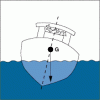Transport Publication - TP 10038 E (2003)
The stability of a vessel refers to its ability to stay upright in the water.
Many different things can affect the stability of a vessel and cause it to capsize. However, these things can be controlled. A well-designed vessel will not capsize even in the worst conditions - if it is operated properly.
Fishing vessel stability is a very complex subject. Some basic rules are outlined below. For more detailed information consult a standard stability text book.
Centre of Gravity
The centre of gravity ( G ) is the point at which the whole weight of the vessel can be said to act vertically downward. As a general rule, a lower centre of gravity means a more stable vessel.
The centre of gravity changes, depending on how weight is distributed in the vessel. For example, a heavy load placed high on deck will produce a higher centre of gravity - and less stability - than a load stored below deck.
A vessel with a high centre of gravity is "top heavy." If it lists or heels to one side, the centre of gravity pushes down in the direction of the list. The danger of capsizing is much greater.


